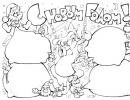Crochet border: diagrams and description. How to beautifully crochet the edges of a product? Step-by-step description of the process
One of the simple and at the same time effective ways to decorate the edge of a product is to decorate it with a crocheted border or border. Correctly selected threads and a hook will give a finished look to both a knitted product and clothing made from fabric.
Application of knitted border
A wonderful decoration is a knitted openwork border, which is found in abundance in magazines. Traditionally, sleeves and hems of clothing, towels and napkins, towels and bedspreads, rugs and other interior items were decorated with this type of trim.
A knitted border is also used in a more extravagant way. For example, they decorate the edge with it leather product, and also decorate pieces of furniture. The lace border is also used in a type of needlework such as scrapbooking.
Methods for attaching a border to a product
Border to the main product, crocheted, the circuits for which are very diverse, can be connected in several ways.
- As a rule, the border is attached directly to knitted items using a hook. The loops of the main item serve as its basis, and it is tied on as a continuation of the main fabric. This is how, for example, the border for shawls is crocheted. Patterns of such finishing can be part of shawl patterns, but can also be selected separately.
- The same method can also be used when decorating fabric products, such as napkins, as borders. In this case, take a small hook (No. 0.3, No. 0.5 or No. 0.75) and thin threads, preferably matching the composition of the fabric of the product that needs to be decorated. The hook is inserted directly into the fabric, and the fabric is tied around the edge with single crochets. Next, the border is crocheted, the pattern of which the needlewoman liked.
- But you can go another way: the edge of the fabric is sewn with an overcast stitch using a needle, into which a thread is threaded, which is later intended for crocheting. Border patterns are selected arbitrarily. In this case, the seam stitches will form the basis, and the canvas will be tied to it.
- The next method seems to be the simplest: a border is crocheted separately, the pattern of which is suitable for the design of a particular product, and then sewn to the fabric, overlapping sewing machine or manually. But this method may turn out to be much more complicated than the previous ones in practice. The fact is that a crocheted border has more elasticity than fabric, so when sewn on it can stretch somewhat so that the length of the edge of the product and the border itself do not coincide. To prevent this from happening, it is recommended to knit a sample of the border and accurately calculate the knitting density, i.e., calculate how many loops there are per 10 cm of the product, and then make the necessary calculations.
A crocheted border, the pattern of which you like, can be created in two ways: along or across.
Border knitted across

The border, knitted crosswise, is performed in a circle (if it is necessary to tie a sleeve, the hem of a dress, or a napkin) or in rotating rows until it reaches the required width. The most simple view This type of finishing is the so-called “crawfish step”. A simple single crochet, double crochet or multiple crochet stitch can also be considered a variant of the border. Even a novice needlewoman who is just mastering a technique such as crocheting can cope with this design method. Border patterns are not required in this case.
Border knitted along

You can knit a border along the fabric being tied. The width of such a border is set by the pattern, and the length can be adjusted during the knitting process. At first glance, “guessing” the required length of such a border is easier than the dimensions of the transverse one, but it still doesn’t hurt to knit a sample and calculate the knitting density. This is necessary so that the border when decorating the product does not end “suddenly” in the middle of the repeat, which will negatively affect the appearance of the finished product.
Openwork border

The product is perfectly complemented by a crocheted openwork border. Schemes and descriptions of such handicrafts are easy to find. This border looks very impressive. The crocheted border is especially beautiful, the pattern of which contains a pattern of various types“shells”, “pineapples”, festoons. Such a border can consist of one row of “shells” or other elements, or it can be quite wide - it depends on the chosen option.
It’s simply amazing how an openwork crocheted border can be crocheted in different ways. The patterns for its implementation range from the simplest to those that only an experienced knitter can do.
Multilayer openwork border
An openwork border can consist of either one row or several dozen rows, which is especially important when knitting skirts, flounces on sleeves or trousers. In order to create a wide crocheted border in several tiers, the most common patterns are taken. Then proceed as follows: knit the first tier according to the pattern, then knit to it from the wrong side thick fabric, consisting, as a rule, of columns with one or two crochets. In order to save threads and to make the product lighter, dense fabric is often replaced with fillet mesh. The width of such an element is made slightly less than the width of the openwork flounce. Next, the next shuttlecock is tied on it. If you knit the fabric with increases, then each next tier will be more magnificent than the previous one.
Sirloin border

Borders made using the fillet technique are traditionally used to decorate textiles: napkins, towels, curtains. But even as a decoration for clothing, such lace looks very attractive, especially in combination with the fillet inserts that decorate the product itself.
There are many patterns for creating a fillet border. Some are specifically designed for knitters. But a crocheted fillet border, the patterns of which were originally intended for embroidery, especially monochrome, will also look good.
Ribbon lace border

Usage ribbon lace It also seems like a good idea as a border. It looks impressive, especially in combination with a simple knit or fabric. In addition, when decorating clothes, it will look organic, for example, the bottom of the product, decorated with a border of ribbon lace, in combination with a belt made in the same technique.
Knitting is not as simple as openwork, but the result is a truly unusual and original crochet border. Patterns and descriptions, as well as master classes on knitting ribbon lace, can be easily found.

Border with Irish lace elements
A special place is occupied by borders created using elements Irish lace. They are knitted using the technique continuous knitting. But you can create a border of flowers and leaves, traditional for “Ireland,” by connecting them together using an irregular mesh or in a concatenated manner.
For example, they look advantageous kitchen towels or curtains decorated with a border with elements of Irish lace and knitted elements sewn onto the fabric, which do not contradict the style of the border. Crocheted borders with patterns of this kind, of course, can be found, but you can do without a specific description by showing your imagination.
The role of color in creating a border

Traditionally, the border is knitted in a single color. The color can either match the tone of the main product, or be combined with it or contrast - it all depends on the taste and imagination of the knitter. But use various shades when creating a border it is also not prohibited. On the contrary, plain items decorated with multi-colored borders look cheerful and bright.
And, of course, a multi-color border will look impressive if the needlewoman decided to decorate the product not only with a border, but also, for example, with a knitted applique or three-dimensional crocheted elements. The same colors used to create similar embellishments and borders create a cohesive look, making the finished piece more attractive and interesting.
Below are a few simple descriptions crochet border.

Shell
This is a simple openwork border, knitted in one row. It consists of single crochets, half double crochets and double crochets. In order to perform this binding, turn the product to the front side, perform 1 chain lifting loop, knit a single crochet into the next loop, then a half double crochet into the next loop, then 3 double crochets into the same warp loop and then a half double crochet again. double crochet A single crochet is worked into the next loop again. Then continue in the same order.
There is another way to knit shell-shaped borders. This finish consists of 3 rows:
- 1st row: knit 3 air loops lifting, skip 1 warp loop, then knit a single crochet into the next loop. Then rapport is performed: 1 air loop is knitted, 1 warp loop is skipped, 2 double crochets are knitted into the next loop, etc.
- 2nd row: knitting is turned and 5 chain loops are knitted (3 lifting loops and 2 chain loops), then 1 single crochet is knitted on the chain loop of the previous row, 4 chain loops and again 1 single crochet on the chain loop of the previous row. At the end of the row, 2 chain stitches are knitted; 1 single crochet is performed in the last loop of the previous row.
- 3rd row: knitting is turned, 1 air loop and 1 single crochet are knitted. Next, a shell is made into the arch of 4 air loops of the previous row in the same way as it was done in the previous sample: single crochet, half double crochet, 3 double crochets and single crochet. The shells are knitted in this way until the end of the row. The row ends with a single crochet in the third loop of the chain of 5 chain loops of the previous row.
Fringe
The border in the form of a fringe looks original. You can also knit it in several ways:
- A series of single crochets is knitted. The next row is performed in this way: 1 chain stitch, 1 single crochet at the beginning of the row, then a rapport is made - 1 single crochet is knitted into the next loop, a chain of 15 chain stitches and a connecting stitch, knitted in the same loop of the previous row as previous single crochet.
- The fringe in the idea of “springs” is performed in the same way as the previous one, but after creating a chain of 15 air loops, continue knitting on it. 1 chain stitch is skipped, then 2 single crochets are knitted into each chain stitch. The finished “spring” is attached to the base with a connecting post, as described in the previous version.
The shell pattern allows you to knit a very beautiful border, which is perfect, for example, for a baby blanket. The rounded scallops formed by the edges of the shells allow you to create a very delicate and elegant edging around a knitted product. A similar border is knitted directly along the edge of the product and usually starts with an even number of rows, connected with single crochets. If you are crocheting a rectangular blanket, you may need to adjust the number of stitches in the last single crochet round (by making one or two increases or decreases on each side) to ensure that the double crochets that separate the shells are exactly on the corners.
To create a wide border

(photo above) Before knitting the shell pattern, work an even number of rows of single crochets. If you knit shells directly along the edge of the product, you will get a narrower border (photo below).

Shell border
1. Start at the right edge and, working on the right side of the piece, work an even number of rows with single crochets.

2. Start the row of shells with 1 chain stitch and skip the 1st single crochet.

3. Skip 1 single crochet, make 5 double crochets in the next single crochet, skip 1 single crochet and work 1 single crochet in the next single crochet. You will get one shell.
4. Repeat the sequence of step 3 along the entire edge. Please note that in the corner loop you should knit a single crochet,
which separates two shells. And for this it is necessary that each side of the last row of single crochets consists of 4 times the number of loops.

5. Continue until you have tied the entire edge of the product. Finish the border by knitting the last single crochet in the first chain stitch.

Working on the right side of the piece, start on the right and work an even number of rows with single crochets.
The total number of loops must be a multiple of 4+1.
Row of shells: 1 ch, skip 1 sbn, * skip 1 sbn, 5 dc in the next sbn. skip
1 sc. 1 sc in next, sc, rep. from * to the end, knitting the last sc in ch. Fasten the thread.
Many needlewomen are mastering the art of crocheting borders. Believe me, this will be very useful to you in everyday life. Using a border, you can decorate napkins and towels, trim the edges of clothes, decorate interior items, curtains and much more. There are many in various ways knitting borders. If you are just learning crochet skills, then choose the most simple circuits, subsequently complicating the task. In our article we will talk about how to crochet a border. Patterns and descriptions of the knitting process will help you create real masterpieces.
Crocheted borders primarily vary in width. In addition, the border can be made in an openwork style or with strict adherence to lines. Experienced needlewomen The following types of border are distinguished:
If you want to knit an openwork border for finishing towels, napkins or a towel, then this is quite suitable zigzag pattern. Run this openwork pattern even a beginner can do it. The main advantage of knitting such a border is that the product is knitted lengthwise, that is, you do not need to calculate the number of loops in advance. You can try the border on finished product in the process of knitting.
Required materials:
- threads (iris, cotton or synthetic with lurex);
- hook;
- needle.
Step-by-step description of the process:

We knit a wide border
The wide border can be used to trim children's clothing or women's skirts. Depending on the yarn chosen, such a border can be a wonderful decoration for home textiles.
Required materials:
- yarn;
- hook;
- needle.
Step-by-step description of the process:

Crocheting an edge: a master class with diagrams
To lengthen a child's item, sometimes you need to crochet the edge. Very often, needlewomen tie the edges of sweaters and vests they knit so that they do not curl and constantly keep their shape. Let's figure out how to do this. Basically, the “Shell” border is chosen for tying the product.
Crocheting the edge of the product is, although the last, but very important stage of working on the item. A sloppy piping can spoil the appearance of an otherwise flawless piece of work, and vice versa - a beautifully piping edge can become the highlight of a banal creation.
Crocheting the edge of a product can be done to solve different problems:
1. Giving a finished look to things knitted not only with crochet, but also with knitting needles, or on a machine.
2. Anti-twist knitted fabric, ensuring edge rigidity and preventing its deformation.
3. Updates of outdated or boring things.
Popular and practical ways of tying products
When you crochet things, you will probably come across the term “crawfish step”. This pattern is most often used for binding the edges of products, as it looks impressive and does not allow the edge to stretch. But they can also cover up an unsightly seam or add texture to applied decorative elements.
How to crochet the edge of a product with a “crawfish step” pattern? Insert the hook into the first loop on the right and knit single crochets, but not as usual, but in the direction from left to right (see picture below). That's why this pattern has such a fancy name.
Tying with a simple single crochet will look impressive if you use contrasting yarn. It is perfect for functional items, such as potholders, where the strength of the product is important. This pattern is simple to make: insert a hook into each edge loop and knit a stitch. At the corners you should make 3 stitches in one loop so that they do not pull together or turn inward.
A simple option for decorative crocheting edges
Of course, these are arches made of air loops, the lightest of all possible ways how to crochet the edge of a product, and at the same time very delicate and attractive. Tying round napkins with arches looks especially impressive.
The pattern is done like this: on a warp loop we make a single crochet, knit the desired number of chain stitches (3-10), skip a few warp loops (2-3 less than chain stitches), then we knit a single crochet. And so we continue to knit further.

In order for the arches to fit beautifully, you cannot stretch them too much over the edge or, conversely, compress them too much. They should form a smooth semicircle.
Patterns for processing borders
Often a modest and compact crocheting of the edge of the product using a picot pattern is appropriate.
Pico is a chain of 3-7 air loops closed in a circle. It is knitted like this: after two single crochets, make 3-7 air loops, insert the hook into the base of the single crochet and close the loop. Picot can come in different sizes and frequencies, allowing you to play with the appearance of the border. Often beads are tied into it. The diagram is below.

The Shells edging pattern works well in its simplest form and in more intricate versions that involve different combinations of subsequent shell rows or combinations with other knitting techniques (see pattern below).
Crocheting the edge of the product with the “Shell” pattern is done according to the following principle: several double crochets are made in one loop. It turns out to be a beautiful round shape. Before and after the shell, we skip such a number of loops so that the number of loops added by the columns is equal to the number of skipped ones. For example, if there are five double crochets in a shell, then we pass two chain loops to the left and right of it. Then knitted fabric It turns out smooth and neat. For taller shells, stitches can be made with double yarn overs. Sometimes, for the convenience of completing subsequent rows of the pattern, an air loop is added in the middle of the shell.

Pattern " Curvy columns“looks intricate, but is done simply and quickly. It looks better on thick yarn, keep in mind that the thread consumption will be high. The pattern is made like this: we make a rise from air loops, yarn over, insert a hook into the wall of the base loop and pull out a long loop. Without knitting it, we repeat the yarn over and the long loop, achieving the desired splendor of the column. Then we make a yarn over and knit all the loops with one.

Multi-row openwork borders
Can be radically transformed appearance things, if you intricately crochet the edge of the product. Schemes of such patterns will require certain knowledge and skills from the needlewoman, but most often at first glance they look more complicated than they actually are. Combinations of simple elements allow you to create a wide variety of borders. For example:

If you are going to improve the look of towels or kitchen napkins, you can knit the border separately, and only then sew or tie it to the edge. So, if the towel loses attractive appearance, you can replace the lace with a new one.
How to crochet the edge of a product neatly and beautifully
Before you get to work, you need to knit a small sample of the border separately - to see how a particular pattern looks, where it can tighten the fabric or, conversely, lie wavy.
Consider the dimensions of the surfaces for tying - for example, if you are working with a rectangle, select a pattern with so many loops in the repeat so that the pattern is complete on both the short and long sides.
It is better to tie the product more thin thread than the base. This edge will look neater and lighter.
Crocheting the edge of the product using beads, sequins, and seed beads gives the item an elegant look.
Thin napkins and handkerchiefs are crocheted with a thin thread using a crochet hook. small size. The edges of the product are folded, pierced with a hook and a base row is made. This is followed by a series of single crochets, and then work begins on the chosen pattern.
Fantasy yarn - how to make a simple thing original
A variety of fancy yarns have appeared in specialized stores, the sight of which makes craftswomen's hands reach for the treasured skein. Of course, the thread can be multi-colored, shiny, combine different textures, include ribbons, accessories and even pieces of fur. But how to tie the edge of a product with fancy yarn to avoid bad taste? Choose plain products of simple shapes to pair with this thread. It can be used to decorate the neckline, sleeves and hem of clothes, handbag flaps, ends of scarves and glove cuffs. For blankets, decorative pillows, chair covers and napkins, some types of yarn are also perfect.
Many needlewomen are mastering the art of crocheting borders. Believe me, this will be very useful to you in everyday life. Using a border, you can decorate napkins and towels, trim the edges of clothes, decorate interior items, curtains and much more. There are many different ways to knit a border. If you are just learning crocheting skills, then choose the simplest patterns, subsequently complicating the task. In our article we will talk about how to crochet a border. Patterns and descriptions of the knitting process will help you create real masterpieces.
What types of border are there?
Crocheted borders primarily vary in width. In addition, the border can be made in an openwork style or with strict adherence to lines. Experienced needlewomen distinguish the following types of border:
Crochet openwork border: diagrams and description
If you want to knit an openwork border for finishing towels, napkins or a towel, then a zigzag pattern is quite suitable. Even a beginner can make this openwork pattern. The main advantage of knitting such a border is that the product is knitted lengthwise, that is, you do not need to calculate the number of loops in advance. You can try the border on the finished product during the knitting process.
Required materials:
- threads (iris, cotton or synthetic with lurex);
- hook;
- needle.
Step-by-step description of the process:

Wide crochet border: diagrams and description
A wide border can be used to trim children's clothing or women's skirts. Depending on the yarn chosen, such a border can be a wonderful decoration for home textiles.
Required materials:
- yarn;
- hook;
- needle.
Step-by-step description of the process:

Crochet edge: patterns
To lengthen a child's item, sometimes you need to crochet the edge. Very often, needlewomen tie the edges of sweaters and vests they knit so that they do not curl and constantly keep their shape. Let's figure out how to do this. Basically, the “Shell” border is chosen for tying the product.
Required materials:
- yarn;
- hook.
Step-by-step description of the process:

Knitted items are always in fashion, especially those made by yourself. If you want to make your clothes or home textiles original, then tie them with an openwork or wide border. There's nothing complicated about it. You will see, you will definitely give many things a second life.






